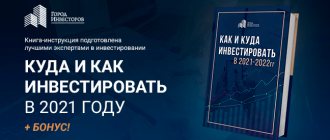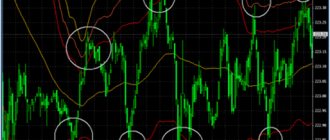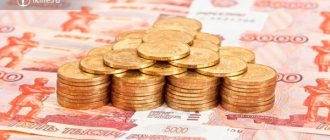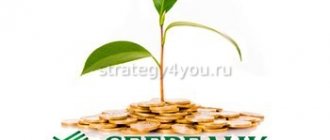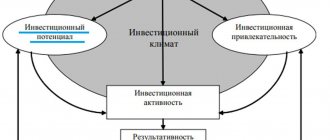Investment greetings, friends! You already know that investing in just one asset is a risky proposition. If it becomes cheaper, you will incur a paper loss, which will have to be recorded if the funds are urgently needed. Therefore, it is better to assemble a diversified portfolio of several assets. But how can you create an investment portfolio so that it meets your goals and objectives, is truly diversified, and consistently generates profit? This is a very complex question, so let's look at it step by step.
What is an investment portfolio
If we explain the term investment portfolio in simple words, then it is a complex of all the money that is invested in various directions. These can be either real-life objects (real estate, currency, etc.) or objects of the stock market and enterprises (stocks, futures, certificates, bonds, bills, venture investments, and so on). The investment portfolio plays a very important role in financial science. It is thanks to this instrument that it is possible to diversify possible risks, that is, to compensate for possible losses through profits from other components of the portfolio.
An investor's portfolio is a complex of cash injections of legal entities and private investors into stock market assets.
Balanced
This investment portfolio can be formed by purchasing any shares in three ways. With a conservative approach, those stocks and bonds are purchased that will bring a small profit and have the lowest possible risk of losing the investment. With a moderate (compromise) approach, stocks and other securities are selected that have average indicators: profit in the form of dividends is not huge, but not small, capital grows moderately, and the occurrence of risks is a big question. When aggressive, such shares are purchased that can generate the highest possible profit, comparable to that which bankruptcy auctions can bring. That is, one that would exceed your investment several times in a short time, although the risk of not receiving such a profit will be impressive.
Conservative
Involves the purchase of government shares, other securities or precious metals. One of the easiest ways to get a stable profit with the ability to preserve your own investments: state assets are perfectly protected from any possible risks. Therefore, such principles for forming an investment portfolio are chosen by investors who are not inclined to choose high-risk instruments for investment.
Aggressive
It is formed from various securities and assets that tend to grow and become more expensive. By purchasing them you can quickly make a significant profit. But the risk of losing your investment is too great. Basically, in this segment, shares of technical and innovative start-ups and promising scientific areas are sold and bought. It is quite easy to buy such shares, but finding a buyer for them is more difficult, since their liquidity is low.
How to calculate the total return of a stock
The total return on a stock (or gross return) is the exchange rate growth + dividends accrued for the year. Naturally, if we are talking about annual profitability.
The total return on shares is calculated using the following formula:
( D + (P2 – P1) ) / P1 * 100%.
Let's take the same VTB share as an example. In 2021, based on the results of 2021, VTB paid 0.0011 rubles per share. We already know the price of the share at the beginning and end of the year - it is 0.0378 and 0.0485 rubles. We count:
(0,0011 + (0,0485 – 0,0378) ) / 0,0378 * 100% = 31,21%.
As you can see, this result is higher than the simple yield excluding dividends – it was only 28.30%.
If a company pays dividends several times during the year, then they are summed up.
Sometimes it happens that a company's shares fall during the year, and even dividends do not save from negative returns. Take, for example, Magnit shares. At the beginning of 2021, they cost 4,155 rubles apiece, and by the end - 3,702 rubles. The dividend amounted to 313.97 rubles, which gave a dividend yield of 8.18% (as of the cut-off date).
Let's calculate the total profitability:
(313,97 + (3702 – 4155) ) / 4155 * 100% = –3,34%.
That is, if we bought Magnit shares at the beginning of the year and sold them at the end, then, despite the dividends, we would have to record a loss of 3.34%. And this despite the high dividend yield of the stock as a whole!
And here’s another interesting article: What is a bond offer and why you need to remember about it
How to calculate return on investment in Excel
Excel uses the XIRR function to calculate investment returns based on cash inputs and outputs. This is a function that returns the internal rate of return for a schedule of cash flows that are not necessarily periodic. How to use it? Let's take an example from Arsaghera's article:
- An investor bought shares worth 1000 rubles.
- After 3 months, he bought more shares for 500 rubles.
- After another 4 months, he sold part of the shares in the amount of 300 rubles.
- A year after the initial acquisition, the price of the shares was 1,300 rubles.
The portfolio's return was 8.004% per annum.
Let's enter this data into Excel. In the first column we indicate the amounts, in the second the dates.
- In the first line we indicate the initial investment amount of 1000 rubles and the date of investment, for example 01/01/2014.
- In the second line we indicate the deposit of funds 500 rubles and the date 03/01/2014.
- In the third line we indicate the withdrawal of funds with a minus sign of -300 and the date 04/01/2014.
- In the fourth line we indicate the value of the portfolio at the end of the year with a minus sign of -1300 and the end of the year date 12/31/2014.
Now select some empty cell and press the fx button (insert function). Find the function NET. Enter cell values. In the “Values” line, select cells with amounts, in the “Dates” line - cells with dates.
Click OK, we get a yield of 8.009% per annum.
If we counted using a simple formula, we would get the result (1300-1200)/1200=8.3%. It seems like a small difference, but in other examples the difference can be several percent.
You can also enter a function into a cell by hand. To do this, in an empty cell, enter the text: =NET INDEX(A1:A4;B1:B4), enter your cell numbers.
Types of investment portfolios
The devaluation of the ruble and the decrease in the purchasing power of the national currency contributed to the fact that many people became interested in investments. Investments in Russia attracted primarily those who wanted to preserve their savings and increase them. But in order to invest successfully, you must first study the main theoretical aspects of financial investments, because the investment portfolio can be different.
There are several types of investment portfolios based on the type of formation, management, set of assets, degree of risk and other parameters. For example, this could be a cryptocurrency portfolio, an investment portfolio of shares and other stock assets, or even a mixed investment portfolio that contains a variety of instruments. Let's consider the most interesting types from the point of view of a private investor who wants to receive passive income and what they consist of.
Income Portfolio
This investment portfolio is formed by purchasing cheap securities that tend to rise in value. The possibility of a multiple increase in value and high profits forces investors to take significant risks, as a result of which they can lose the entire amount of investment. Selling such securities is problematic. But with an increase in rates, you can increase the amount of investment several times. One of the subtypes of an income portfolio today is investing in cryptocurrency.
Growth Portfolio
When forming such an investment portfolio, they buy shares of young and promising companies. Such companies tend to grow and develop, which is accordingly reflected in the price of their securities. At the purchase stage, it is hardly possible to make a serious profit from dividends, and the risks are high. However, the bet is made precisely on the long term, just as when investing in oneself. With the right choice of investment object, a significant increase in the initial investment is possible.
Risk capital
The name speaks for itself: the level of risk is quite high. But, in the long term, investments in modern technology companies, whose main activity is the development of technologies, the introduction of new products, scientific research and development, can bring both profit and investment injections will increase several times. The fact is that the activities of these companies lie in a sector that is interesting to the state: there is a high probability for businesses to receive government grants and other types of assistance.
Long-term securities
Such securities in your investment portfolio can play a positive role. You can take a passive position and simply watch the growth of your invested funds. Such long-term securities include bonds, bills, notes, bonds, shares and other types of securities of private and public companies valid for more than one year. The possibility of losing your money is assessed as quite low, and dividend income is received regularly.
Short-term securities
Similar to long-term, short-term securities may include government short-term bonds, bills (bank, treasury, corporate), certificates of deposit. Such securities have a limited validity period - usually no more than a year, but they sell well (high liquidity) and are fairly well protected from risks. In addition, the income received is not subject to taxes. It is not possible to make a good profit from such securities. But this is an excellent investment portfolio for those who want to preserve their savings.
Foreign papers
Similar to Russian ones, foreign enterprises and foreign government agencies and structures put various types of securities on stock exchanges, where any individual or organization can buy or sell them. There are also long-term and short-term liabilities. The only important point when forming such a portfolio is the need for careful analysis. For example, if you invest in short-term securities, you can increase your profits, but the investment risk is also high. Investments in long-term securities can protect investor investments quite well; it is necessary to choose government shares and issuers that have been on the stock exchange for a long time and are known.
Online investing
One of the new directions is investing financial investments via the Internet. There is a fairly wide range of funds and companies where you can invest. Starting from PAMM investing in Forex exchanges, private investment funds, lending to legal entities and individuals, indirect lending through the WebMoney system to startups of alternative cryptocurrencies. When forming an investment portfolio from such instruments, there is a high probability of running into both scammers and a financial pyramid and losing your investment. To prevent this from happening, you need to be able to forecast cryptocurrencies and their rates, and select only reliable projects.
Expected return on securities
Competent investment in securities involves a probabilistic assessment of risks and opportunities, selection of an acceptable risk value and a comparable potential level of profitability**. We talked to you about investment risks and ways to minimize them here. Now I will tell you how to assess the potential profitability of securities.
You can estimate expected return (ER) using two different methods. The first method is based on probabilities (mathematical expectation), and the second is based on historical data. Let's start with the probabilistic estimation method.
Profitability assessment based on mathematical expectation
In this case, all possible options for the size of the expected return are taken into account, along with their probability. Moreover, the greatest weight is given to those values whose probability of obtaining is higher.
The calculation is made using the formula:
To make the calculations clearer, let's give a simple example. Let’s say an investor is faced with a choice of two securities with the following distribution of probabilities of profits for them:
- Security A is expected to yield a 10% return with a 50% probability, a 7% return with a 30% probability, or a 4% return with a 20% probability;
- Security B. The probability of a return of 12% is 30%, the probability of a return of 8% is 35%, and the probability of a return of 5% is 35%.
First, we calculate the expected return for security A:
OD = (0.1*0.5) + (0.07*0.3) + (0.04*0.2) = 0.079 = 7.9%
Now let’s calculate the expected return for security B:
OD = (0.12*0.3) + (0.08*0.35) + (0.05*0.35) = 0.081 = 8.1%
Obviously, the actual profitability value will most likely differ slightly from that calculated using the above formula. You can evaluate the spread of actual values relative to calculated values by calculating the dispersion value.
The variance is calculated using the formula:
For our example, we get the dispersion for paper A:
0,5(0,1 — 0,079)2 + 0,3(0,07 — 0,079)2 + 0,2(0,04 — 0,079)2 = 0,000549
And the dispersion for paper B:
0,3(0,12 — 0,081)2 + 0,35(0,08 — 0,081)2 + 0,35(0,05 — 0,081)2 = 0,000793
Dispersion shows the level of risk that will entail investing in a security for which the expected return was calculated based on probabilities (mathematical expectation). The greater the dispersion, the greater the possible deviation of the actual OD value from the calculated one.
In our example, the dispersion for paper B is slightly higher than the same indicator for paper A. However, the difference between them is quite insignificant (not an order of magnitude), so we can assume that the risks of the securities under consideration are approximately equal. Therefore, all other things being equal, investing in security B is preferable.
Profitability estimation based on historical data
As you understand, it is not always possible to objectively assess the likelihood of receiving a particular amount of profit. Therefore, in practice, the second method of assessing OA is often used. For the second method of calculating OA, it is assumed that there is data on profitability for several equal time periods (for example, several years).
The calculation is made using the following formula:
For example, let's again compare the shares of two companies A and B. To simplify the example, let's take the annual return statistics for the last three years. Let the shares of company A generate income in the amount of:
- First year - 10%;
- Second year - 8%;
- Third year - 15%.
A shares of company B:
- First year - 5%;
- Second year - 15%;
- Third year - 10%.
Substituting these values into the formula we get, for shares of company A:
AP = (10+8+15)/3 = 11%
For company B shares:
AP = (5+15+10)/3 = 10%
As you can see, according to the calculation, the shares of company B are slightly more profitable. However, it should be borne in mind that profitability values in the past do not guarantee it in the future. So, in this example, in the third year there was a slight decrease in profit. This may be caused by either temporary but surmountable difficulties (caused, for example, by changes in market conditions), or indicate more serious problems for the company (the presence of which will most likely entail a further decrease in the profitability of its securities).
Formation of an investment portfolio
The implementation of any investment, one way or another, is associated with defining the objectives that the investor must achieve. This could be: increasing the amount of cash injections, receiving quick and large profits, accumulating securities with a high degree of liquidity and reducing the level of risk for your own funds.
Moreover, the predominance of one of these parameters invariably entails a change in all others. A direct relationship is visible: an increase in profitability invariably increases risks, an increase in capital investments minimizes income, high liquidity minimizes the level of growth in capital investments, and vice versa. But in order to form your own profitable investment portfolio, you need to go through several stages.
Setting investment goals
At the first stage, you need to decide what effect you want to achieve from your investment. Make a profit, save up, become a co-owner of a company or participate in the management of a company, save the invested amount, etc. Along with choosing a goal, they plan how long it will take to achieve it, what the level of income will be, what risk you are willing to take and what level of asset liquidity you are willing to operate with.
Investment strategy
This concept hides all those activities whose purpose is to achieve the objectives of the investment project: preserving or increasing capital, creating a source of constant profit, etc. The strategy can be aggressive - the investor’s actions are aimed at investing a little and getting a lot as quickly as possible. Next comes the conservative strategy: the investor invests to save the money invested. And a moderate strategy: maintaining financial investments, increasing them and obtaining a certain profit. Choosing a strategy is the second stage.
Market analysis
At the third stage, a comprehensive study and analytical assessment of the objects where it is planned to invest portfolio investments is carried out. The investor chooses a financial market product that can fully satisfy his expectations. That is, from a mass of options, those that will be included in portfolio investments in the future are selected.
Selecting assets for investment
The investor chooses where and how to invest money, in what proportion. Either this is an independent acquisition of securities in a certain ratio, or the purchase of a share from the management company of an investment fund (in one of the articles I talked about the principles of trust management). The set of assets is formed in such a way as to correspond to the achievement of goals with minimal possibility of threats of loss of investments. In addition, you should take into account the fact how you plan to manage your investments.
Investing and profit monitoring
When investing in assets, it is necessary to carry out a procedure such as monitoring. That is, monitoring the current situation in the stock markets, purchasing promising ones and getting rid of non-income-generating assets. It’s difficult to figure this out on your own, but under the trusted management of experts, investments will most likely be preserved and grow: experts will respond to all current changes and are able to identify niches that are attractive for investment.
Payback period of investment
The essence of this method is to calculate the period at which the investor will return the funds invested in the project and begin to receive net profit. The payback period is calculated (see Calculating the payback period of an investment project: main goals) as the ratio of the investment amount to the annual profit brought by the investment object.
This method is conditional and does not take into account many factors. In addition, this calculation assumes the full investment of funds in one amount and receiving the same income every year. For countries with unstable economies, a formula is used that takes into account the discount factor, that is, the change in the real cost of funds.
Investment portfolio management
You can manage portfolio investments yourself if you have the appropriate experience and qualifications. Or entrust the management to a qualified expert. All actions of a specialist to change the composition, increase or decrease assets will necessarily be agreed upon with you. The problem that management must solve is maintaining income at a certain level. There are two types of management; let’s look at each in detail.
Effective investment management requires a professional approach, knowledge of market mechanisms and the ability to quickly respond to any changes.
Active control
This method is suitable for experienced players in the investment market. Relevant qualifications required. Knowledge of the mechanisms of the investment market will not be superfluous. The ability to quickly navigate and react to any changes is mandatory. Active management involves actively redistributing investments in accordance with market fluctuations.
Passive control
Passive is a type of management in which, at the investment stage, the creation of a diversified set of assets is achieved. Diversification of an investment portfolio means a set of securities with equal characteristics, the diversity of which reduces overall risks. The mix of assets remains unchanged in the long run. Changes are only possible if there is a significant difference between expected and actual results. Diversification of the investment portfolio must be given close attention to any investor.
How much can you start investing from?
You can start creating an investment portfolio with the very minimum amount – 1–2 thousand rubles. This is approximately how much one bond or minimum number of shares costs. But such investments are unlikely to bring you profit.
The optimal amount to start with is several tens of thousands of rubles. If you fail, at least you won’t lose so much, but you will gain experience and be able to analyze your mistakes.
The most common mistake is relying on quick profits. While your capital is small, it is recommended to independently study the market, follow news and quotes, without relying entirely on a financial advisor (even if you have one). In the future, when you develop your own strategy, it will no longer be necessary to devote a lot of time to your portfolio.
Risks of the investment portfolio
Risks can be systematic and unsystematic. It depends on the likelihood of their occurrence. Types of systematic risks:
- political - military situation, coups d'etat, change of government composition and others;
- environmental - natural disasters: earthquakes, hurricanes, tsunamis and others;
- inflationary - a sharp rise in prices and a high level of inflation;
- currency - are formed as a result of the deterioration of the political and economic situation;
- interest rates depend on changes in the Central Bank of Russia key rate.
Other risks classified as unsystematic:
- credit - borrowers and guarantors fail to meet their obligations;
- sectoral - related to changes in the situation in economic sectors;
- business - the management company made a mistake.
We examined such a concept as an investment portfolio: its possible composition, methods and methods of management, types and other concepts important for a novice investor. It doesn’t matter what you invest in, the main thing is how you do it. Knowledge of the basics of money management and the desire to improve your financial literacy is the key to successfully obtaining a high income.
Author Ganesa K.
A professional investor with 5 years of experience working with various financial instruments, runs his own blog and advises investors. Own effective methods and information support for investments.
Examples of investment portfolios with different risk levels and investment horizons
I will give examples using the classification of investment portfolios and different investment periods.
- Conservative investment portfolio for a period of 5 years (rebalancing - 2 times a year):
- bonds – 50%;
- ETF – 30%;
- deposits – 20%.
- Aggressive portfolio for a period of 2 years:
- startup shares – 60%;
- options – 20%;
- blue chip stocks – 20%.
- Balanced portfolio for a period of 5 years or more (rebalancing - 4 times a year):
- S&P 500 shares – 50%, including:
- IT sector papers – 35%;
- healthcare sector securities – 15%;
- corporate bonds – 30%;
- gold – 10%;
- currency – 10%.
The question may be: why is an aggressive investment portfolio compiled for a short term? This is not a rule, it all depends on what securities you choose, how much you are willing to lose and, to a large extent, Her Majesty’s fortune. In our example, startup stocks that are characterized by high risk. But startups can be both highly profitable and undervalued. Therefore, in my example, after 2 years, the investor is recommended to do one of the following:
- if securities bring high income, rebalance the portfolio;
- if the shares do not make a profit, sell some of them and buy something else, paying attention to undervalued instruments.
Main problems
An important issue is the ability to distinguish the expected rate of return from the required rate. The expected rate of return relates to the level of profit required to finance the objectives. However, the required rate of return is related to the long-term achievement of financial goals.
Factors that may influence investment selection may relate to the following categories: legal conditions (trusts and foundations), taxes, timing, exceptional circumstances or liquidity.
Taxes are associated with the management of the wealth of wealthy individuals, including taxes on income, real estate, transfers of property or capital gains. Exceptional circumstances relate to the asset preferences of organizations. Liquidity refers to the demand (expected and unexpected) of a business for cash. The time horizon is presented as long-term, medium-term, short-term and multi-stage returns.
As a summary
Let's look into the near future, twenty to thirty years ahead. Robots will control not only cars and people's health. Management technologies will be actively supported by artificial intelligence, at least at the assistant level. First of all, this will happen at the operational back level, where production will be designed and launched for a short life cycle with minimal participation of the human factor.
The most creative and most difficult part - the formation and management of investment portfolios - will remain the prerogative of top human managers for many decades to come. Stock markets will become truly global. The financial instruments will expand many times over. The resource base of real projects will seem simply limitless to a contemporary person due to global availability.
One thing will remain - the highest qualification requirements for portfolio managers and innovative creativity, largely devoid of mathematical routine. It seems that such requests are not yet relevant in Russia. This is not true. Managers today can create themselves, focusing on the guiding “leitmotif” of this article.
Types
There are several types of investment portfolios. The table shows the main ones.
| Investment portfolio type | Characteristic |
| Stock portfolio | These are shares of companies with a highly structured fund |
| Balanced portfolio | Stocks of companies with high growth potential, as well as Treasuries and bonds |
| Safe briefcase | Bank time deposits, bonds and treasury bills |
| Active placement portfolio | These are treasury debt instruments, shares of highly structured fund companies and derivative rights |
Assessment of the qualities of real investment objects
The investment portfolio management strategy involves performing a set of assessment measures at almost every stage. Based on an assessment of the investment qualities of objects, the package selection stage is carried out. This requires that there be enough homogeneous objects for competitive comparison. The selection of objects is made through three stages.
- Assessing the effectiveness of objects using standard indicators.
- Comparison and ranking of objects.
- Selecting a package of objects with the best balance of liquidity, risks and efficiency.
Real investments are implemented in the context of the planning and design subsystem with reference to the process of implementing the management strategy and to the process of designing the product and business system. The process of implementing a management strategy has two important outputs: the concept of strategic development and the plan of strategic investment activities. The latter process serves as a source for evaluating and selecting investment objects. When considering objects for direct investment, the following assessment parameters are taken into account:
- level of compliance with the company's development strategy;
- specific scope of the project;
- industry and territory of project implementation;
- project effectiveness from the perspective of economics and market success;
- provision of a material resource base (raw materials, supplies, energy resources);
- the total volume of resource requirements for the project;
- availability of alternative resource sources and level of trust in co-investors;
- intended methods, forms and sources of financing;
- composition of project risks;
- alternative schemes for reducing investment risks.
After preliminary selection, projects undergo a thorough financial and economic examination. A number of projects are justified in the form of developed business plans. The reliability of the information in them is checked, the flows and balances of funds for projects are recalculated. Performance indicators are clarified and the risk of the investment portfolio is measured. For this purpose, fairly developed analytical systems are often used, such as Project Expert, Alt-Invest, which implement the methodology of UNIDO, RRDB or EBRD.



